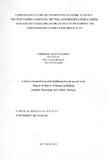| dc.description.abstract | The prevalence of type 2 diabetes is increasing in developing, as well as other countries.
Searching for hypoglycaemic agents with origin from domestic herbals was considered a
useful and promising way to find novel therapy of the disease. This study was designed to
investigate the antihyperglycaemic potential of Aloe secundiflora, Urtica dioica and
Azadirachta indica leaves and assess various dose-response effects in the rabbit and
diabetic Wistar rats. Shadow dried and powdered A. indica and U dioica leaf were
extracted using 60% ethyl alcohol (1:3 w/v). Dried A. secundiflora leaf sap juice was
concentrated in an open vessel. Their formulation mode was improved by constituting
syrup. Diabetes was induced by a single i.p streptozotocin injection (50 mg/kg). Graded
doses of the extracts and placebo were orally administered to normoglycaemic rabbits for
4 weeks. In oral glucose tolerance test male Wistar rats were administered glucose (3g/kg
b.w) 210 min after oral administration of extracts (80 mg kg -I). 80 mg kg -\ b.w of the
extracts was administered orally to diabetic rats for 6 weeks. Control animals were given
glibenclamide and placebo. Blood samples were evaluated using a glucose oxidase kit,
(Human, Wiesbaden Germany). At the end of 6 weeks, the rats were sacrificed by
anaesthesia, whole pancrease and kidney extracted, weighed, fixed in Bouin's solution
and stained by hematoxylin -eosin dye. There was noticeable reduction in blood glucose
levels after chronic administration of A. indica and U dioica extract at 10,20,40 and 80
mg kg -\ in normoglycaemic rabbits. A. secundiflora did not show any effect at these
doses. 100 mg kg -\A. indica and U dioica extracts had statistically significant effect, p<
0.05 against the control. Animals fed on A. secundiflora had decreased appetite and
experienced loose stool. In OGrr model the blood glucose levels of groups fed on A.
secundiflora, U dioica and A. indica were p<O.OOl, p<O.OOl and p<0.05 respectively
compared to control group at 120 min. A. secundiflora, U dioica and A.indica leaf
extracts also produced a significant decrease in glucose level (p< 0.05) of diabetic-treated
compared with diabetic controls. In segment jejunum the percentage fall in glucose
concentration of the medium with initial values was 27.7% for A. secundiflora, 31.6% A.
indica and 36.0% for U dioica against 43.8% for the control during 2 hours. The results
indicate that A. secundiflora, A. indica and U dioica are potential antihyperglycaemics
and can be used in modulating blood glucose levels | en |

